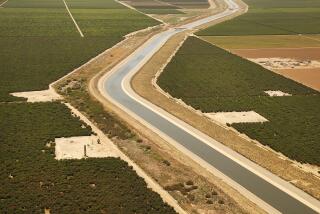Good to the Last Drop
- Share via
“Don’t let the water get in your eye,” New York Mayor Ed Koch said the other day in a typical Kochian remark. “The drought is with us, and will be with us for quite some time.” In fact, the city had just imposed additional restrictions on water use, including a ban on the watering of lawns and the filling of swimming pools. Already prohibited was the washing of autos. Restaurants were not serving water to customers unless asked.
The idea of drought in the Big Apple might bemuse a Southern Californian, particularly one who had been amazed in the middle of summer by the lush natural greenery of the Eastern Seaboard--even in dry years and unassisted by artificial watering. And, the Californian might boast to his New Yorker friends, the Golden State has been awash with water in the past few years.
But guess what happened, just when it seemed safe to be smug about our water supplies. The winter of 1984-85 started out as another banner year, with heavy rains and snows through mid-December, but crashed in the dust of April. Moisture in April averaged only 15% of normal in the Sacramento and San Joaquin river basins. The snowpack at Donner Summit in the Sierra Nevada was completely melted a full month earlier than normal. The current forecast of river runoff into the Sacramento and San Joaquin valleys is only 70% of the 50-year average. State Water Project officials are advising their customers that some promised deliveries of surplus water--water not formally committed under contract--might have to be curtailed late in the irrigating season.
This is not to say that the next drought is around the corner in California. State and federal reservoirs are full or nearly so, in part because of the bounty of recent wet years. Runoff into the Los Angeles Department of Water and Power system in the Owens Valley is normal. And the Colorado River reservoirs continue to brim with runoff from a succession of good water years in the Rockies. Still, a state official says that all water-system operators in California are operating “prudently” this year in the event that next winter is a dry one, too.
The state’s 1985 dry-year designation, one step above critical, is a reminder of how quickly water riches can turn to poverty in California. And while the Colorado River reservoirs are full, Arizona already has begun to take its share of Colorado River water allocated to it more than two decades ago. The first deliveries via the new Central Arizona Project were begun on May 22 to the Harquahala Irrigation District near Phoenix. No longer will Arizona’s apportionment be fully available to Southern California at the turn of the tap to make up for shortages of water imports from Northern California.
There is no crisis at the moment. But Southern California must be better prepared for the next drought than it was in 1976-77. The Department of Water and Power may take a step in that direction this summer by considering, as part of its annual rate increase, a sliding scale of water charges that is designed to encourage conservation. Rates would be higher in summer, when water usage is heaviest, and lower in winter. The department should be supported in this effort as a demonstration of Southern California’s willingness to use more wisely the water that it has now before it seeks to pull more water down from the north. The Metropolitan Water District of Southern California also deserves commendation for its conservation and groundwater-storage programs.
Every drop of water saved now better enables Southern California to cope with the next drought--not if it comes, but when it comes.
More to Read
Sign up for Essential California
The most important California stories and recommendations in your inbox every morning.
You may occasionally receive promotional content from the Los Angeles Times.













